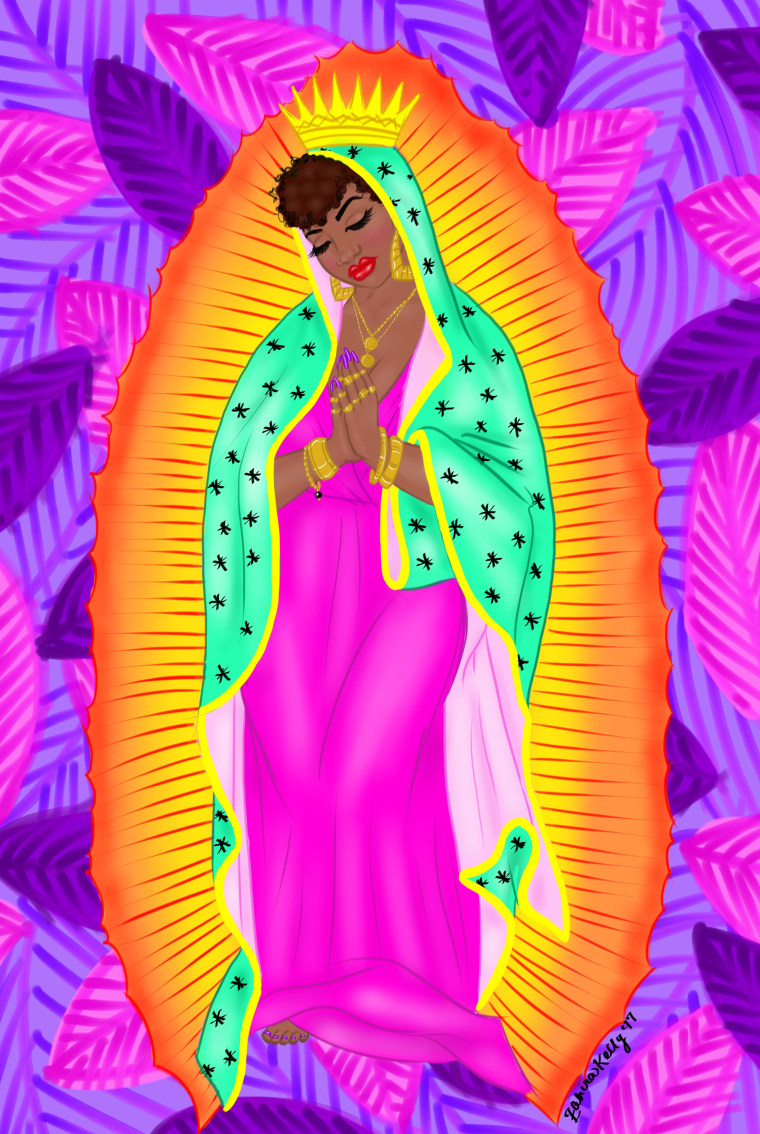 "Virgin Negra"
Zahira Kelly
"Virgin Negra"
Zahira Kelly
The art world can seem very white, depending on where you're looking. So can the Catholic church, where, when I was a little girl, my Cuban and Dominican relatives would take me on rare Sunday mornings.
The churches we went to were boring, and painfully white. Everyone spoke Spanish, a language my entire family speaks fluently, but which I'm not great at. I would often tune out and gaze at the (very white) art that decorated the windows of the church. I didn't see myself, a Black Latina, reflected there, and I couldn't articulate why I felt like I didn't belong. These were my "people," and yet, they all looked and spoke like they were from a different universe.
Georgia-based artist Zahira Kelly’s work places Black women, Negras, at the center of historically white Catholic symbols. A Black Dominicana, Kelly has been drawing since she was "able to hold a pencil," and has been making custom art for underrepresented Black girls for the past couple of years. Her work highlights the magic of Black women, painting them as celestial princesses who know they're too good for you.
I spoke to Kelly over email about navigating through the art world as a Black Latina, how "AfroLatinx" has become a colorist term, decolonizing nudes, and why Cardi B would be perfect for the role of Suicide Squad’s Harley Quinn.
When did you start drawing illustrations?
Art runs in my family. My mother is multitalented, so is her sister. I was raised by them so it all came naturally. My daughter is also great at it. I was drawing as soon as I was able to hold a pencil and women have always been my focus. That’s who I am and who was and is important in my life. I started doing it professionally in my mid-20s. After searching high and low for Black pinup art and finding nothing, I decided to make my own. I casually posted one to an online community of Black girls I was part of and suddenly I was doing custom art for other underrepresented Black girls.
Thinking about your Virgen Negra collection, placing Black women in place of these historically white Catholic symbols, what was inspiration behind creating these?
Catholicism is a part of many Dominicans upbringing and I was no exception. For me, depicting La Virgen as a Negra is fusing our African ancestry with Catholicism like many in our country have done before with spiritual figures. It is also a question: Can you see lower class Black women as the Holy Mother in such a classist, anti-Black misogynist postcolonial landscape? And given historical and recent backlash against Black motherhood (see: Beyoncé), I was curious as to what a Black Virgen de La Altagracia with a Black baby Jesus could look like; how it would be received. While the response was overwhelmingly positive, I did get harassed by some non-Black Latinxs about it. There’s a direct correlation between historically white-leaning standards for Latin American women and rage at the Holy Mother being depicted as Black. So, to quote Bey, “I ain’t sorry.”
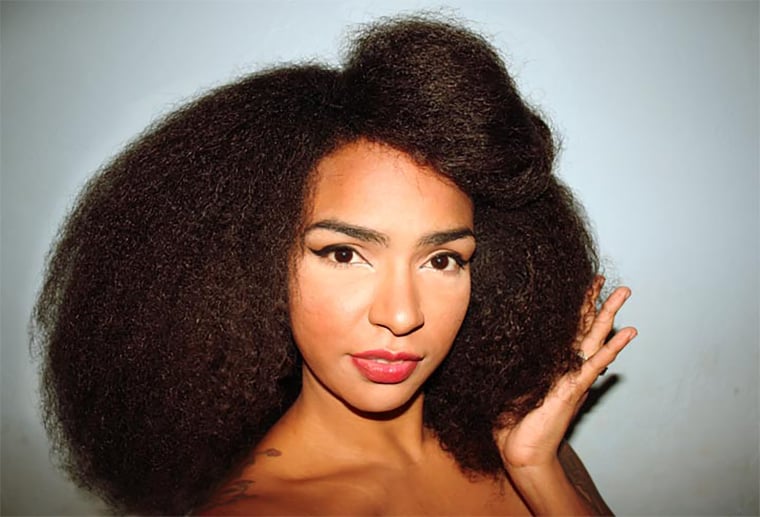 Zahira Kelly
Courtesy of the artist
Zahira Kelly
Courtesy of the artist
“In both my art and writing I simply want to exist freely. To exist, period. That is so elusive when you are a Black LatinAmericana.”
What has your experience been like in the art world, being a Black Latina navigating through these spaces?
I have often been relegated to niche. Depicting only white bodies is considered universally accessible, relatable art. Depicting Black bodies is considered niche, close-minded, even racist. But luckily life is a bit more complex so I have art collectors and patrons from all racial backgrounds and walks of life. Turns out Black girls are humans and thus very relatable.
A lot more people are becoming informed about Afro Latinidad. Do you think the definition of "Afro-Latinx" has changed? If so, why? Is there a difference between that identity and that of "Black Latinx"?
“Afro-Latinx” has now been co-opted by Latin Americans who do not get read as Black in daily life. To where they’re telling visibly Black Latinas they are too Black to be Afro-Latina. Somehow a term for Black pride became colorist and anti-Black. Which is the same horrifying erasure and convolution of our work we sought to avoid when we created that identification. Can’t have nothin’ nice. I am ready to leave it to their trifling asses. I’ma be Black anyway. Have fun being an anti-Black mind-fuck.
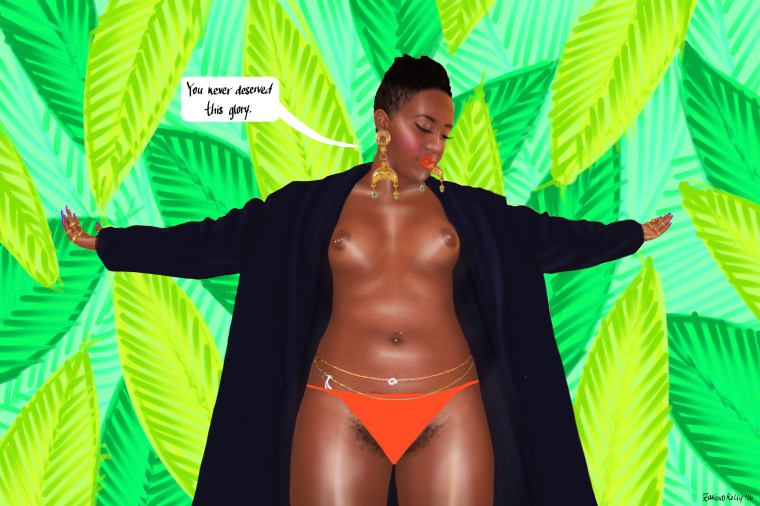 "Nude II"
Zahira Kelly
"Nude II"
Zahira Kelly
“Depicting only white bodies is considered universally accessible, relatable art. Depicting Black bodies is considered niche, close-minded, even racist.”
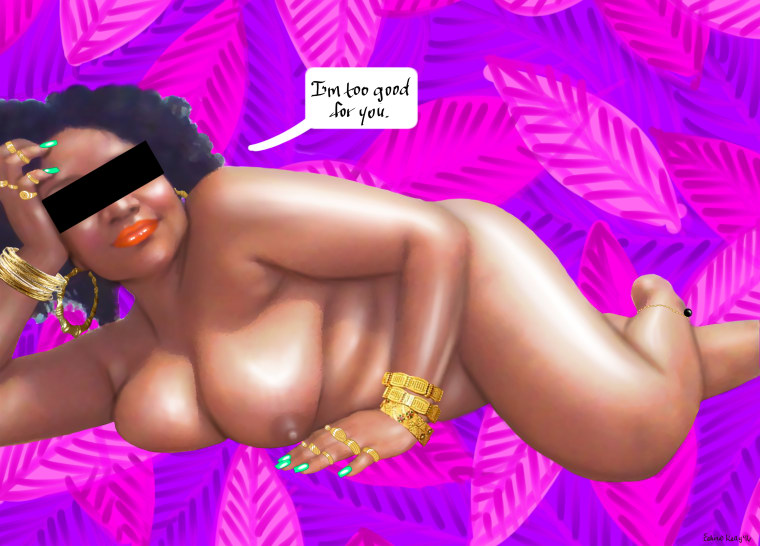 "Nude III"
Zahira Kelly
"Nude III"
Zahira Kelly
For the Nude Series, why did you decide to include talking bubbles ("I can't believe I gave you all this for free," "You never deserved this glory," "I'm too good for you")? And in general, what was the inspiration behind this series?
Nudes are such a contentious topic. They’re referred to as slutty, self-objectification, or for the male gaze; they’re weaponized against women. For many Black women and Native women in the West that is a very colonial notion, that nudity is sin. Colonizers found us topless and nobody used that as an excuse to rape or call us hoes until they got here.
In this series I sought to complicate that [notion] and instead show Black women who are historically devalued, speaking on how extremely valuable they are. They’re odes to self-love when the colonized, enslaved world has tried to tell us we are unworthy of any love at all for 600 years. There are several more pieces to the series. I am exploring my options to exhibit the rest of them in the near future.
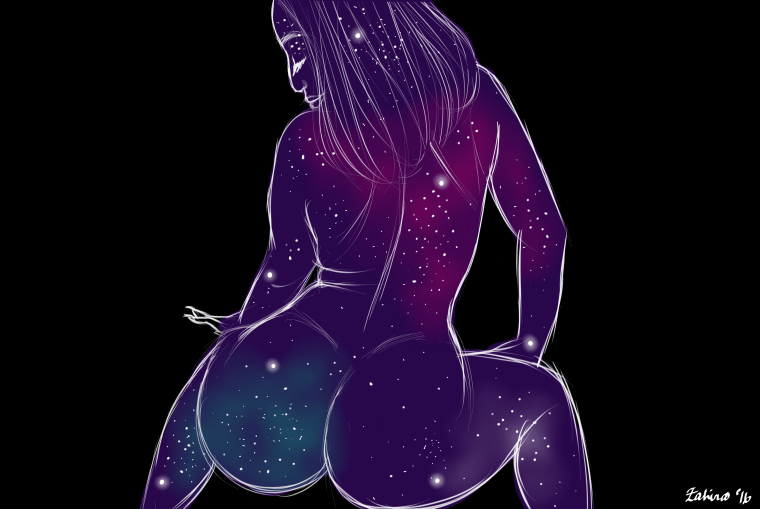 "Galaxy Princess III"
Zahira Kelly
"Galaxy Princess III"
Zahira Kelly
“We are walking universes. Booty shaking is part of our ancestral lineage and retained through hundreds of years of violent suppression and repression.”
For the Galaxy Princess series, what was the inspiration behind putting these figures in motion (twerking, etc)?
It was initially inspired by a video clip going around Twitter of a dancer twerking in glittery galaxy bodypaint by @bodypaintking on IG. I was mesmerized at the sheer Black Girl Magic. And then I studied videos of Miss Twerksum to draw the figures. They shaped up to be a celebration of Black femmes cultural dance, sexuality, magic and glory. We are walking universes. Booty shaking is part of our ancestral lineage and retained through hundreds of years of violent suppression and repression. We and our ass-shaking matter.
What made you paint Cardi B as Harley Quinn?
First off, I’m a huge Cardi B fan. She needs to be canonized. My friend @twittahoney mentioned Cardi B should’ve played Harley Quinn in the Suicide Squad film. After watching it, I also decided a witty, mouthy Dominicana from the Bronx popping gum in sneaker heels, swinging around a baseball bat would’ve made a lot more sense. I don’t have “cast Cardi B in whatever I want” money, but I can draw her as Harley Quinn.
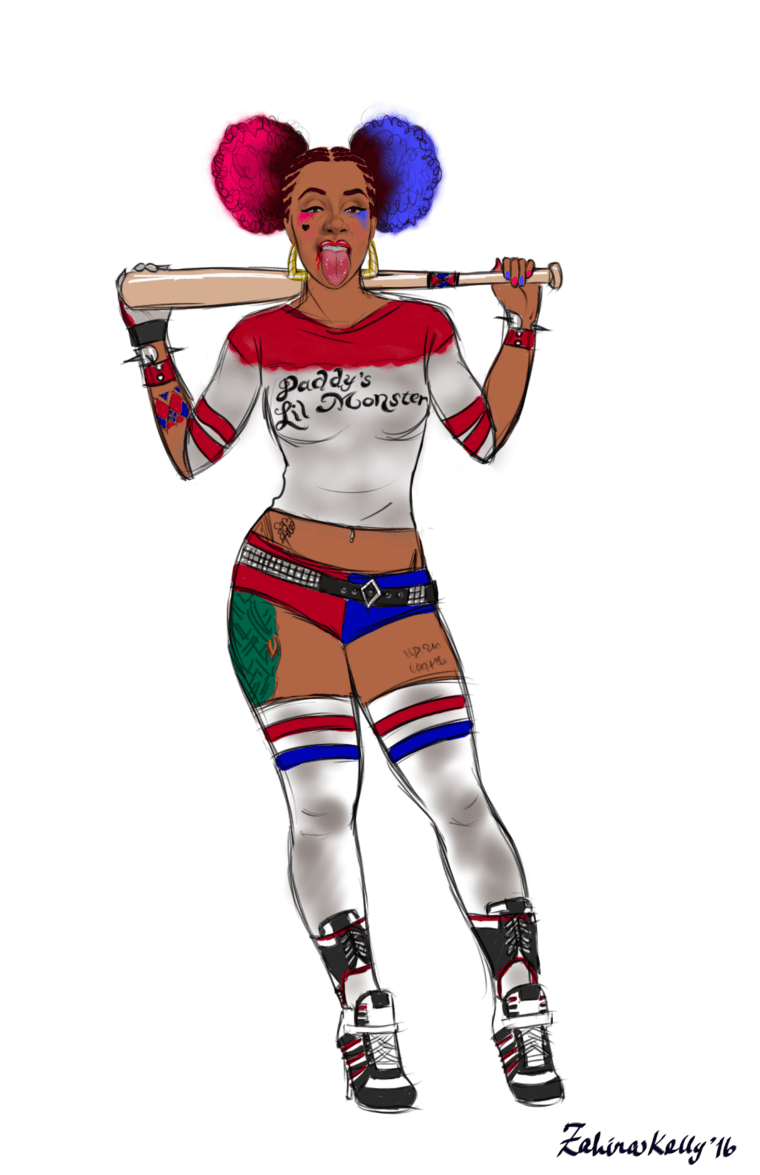 "Cardi B as Harley Quinn"
Zahira Kelly
"Cardi B as Harley Quinn"
Zahira Kelly
Who do you hope to reach with your art? What do you hope to express?
In both my art and writing I simply want to exist freely. To exist, period. That is so elusive when you are a Black LatinAmericana. Our mere existence is a point of contempt and topic of debate. I do what I want. I depict my life, my interests, my thoughts, because I finally realized I am allowed to as a human. We spend our lives consuming media and art for and by anyone but ourselves as Black Latinas, so I am always happy to hear others can identify or are inspired to also express their own life and assert their existence. Sometimes simply being visible is resistance. And I’m ever grateful for having found support in my creative ventures.
Check out Zahira Kelly's art on her website, and follow her on Twitter and Instagram.


